A Cultural Walk Through Patan and Bhaktapur: Timeless Cities of Art
Introduction: Timeless Cities in the Heart of the Himalayas
While Nepal is renowned for its breathtaking mountains, the mountains may not always be representative of Nepal. What may be representative of Nepal are its valleys, and without a doubt, the essence of Nepal is the Kathmandu valley where there are actual civilizations that still exist, and great art that still exists. In the Kathmandu valley, we recently came to discover two living art cities, Patan and Bhaktapur. These cities are unlike any other city in Nepal today because they represent another time, and they also fully embrace, value, and promote the forms and functions of art/culture that we cremate in the urban life, and the extent to which art can operate: hints of earlier cultures and civilizations.
Strolling culturally through Patan and Bhaktapur will be as close to traveling in time as we can arrive at, because all around, you will see beautifully carved temples, durbars, courtyards, artisan villages, and food culture that integrates all of it from pockets of the past, some gone, but some are still vibrant, lively and most importantly, dispersed through the fluvial history of art of the Kathmandu Valley. This blog will take you on an exhaustive journey through the roads, historical gems, the art over time in Patan and Bhaktapur.
Part I: Patan – The Artistic Jewel of the Valley
1. A Brief Historical Overview of Patan
Patan is also called Lalitpur and is one of the oldest continuously inhabited cities on Earth. It was first established sometime in the 3rd century B.C.E. Patan became very important during the Malla period and was established as an independent kingdom noted for its very high level of artistic sophistication. The Malla kings devoted a lot of time, effort, and resources to building temples, town planning and had a great interest in fostering conflict resolution between the Hindu and Buddhist faiths. The dynamic relationship between both faiths would become the heart and soul of Patan as evidenced by the multiplicity of chaityas, vihars, and temples in the city.
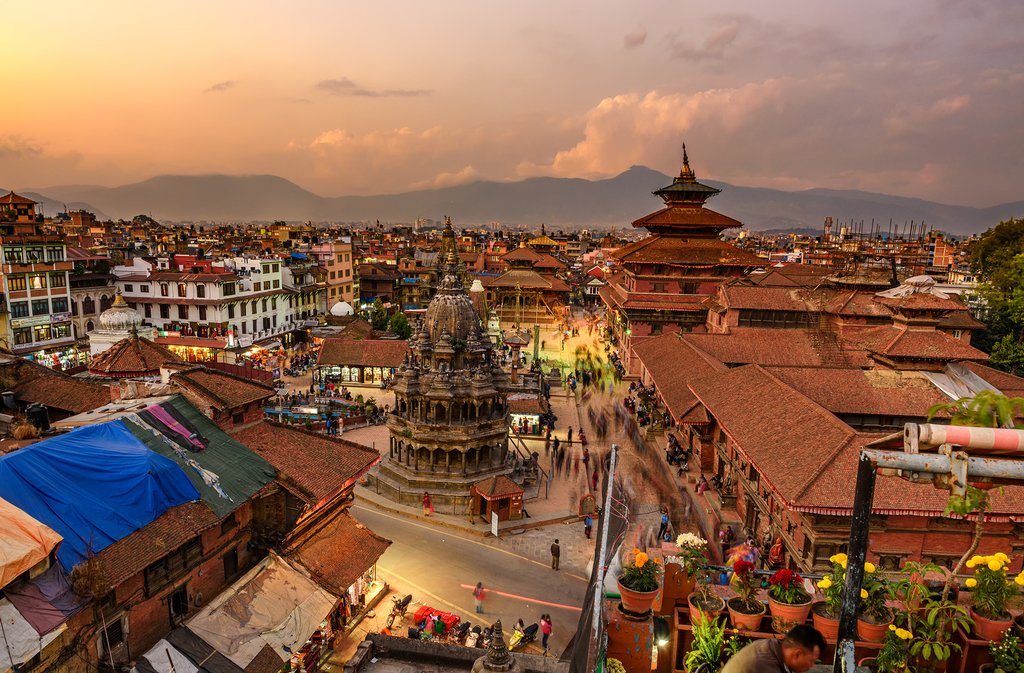
Patan is planned as a Buddhist mandala. Mandalas are sacred and civic space combined into a single spiritual and geometrical expression. The spiritual plan of the city of Patan fully exists to the present day and orchids of stupas dating to Emperor Ashoka exist in each of the four cardinal directions of the ancient city. Urbanism and the city’s population has moved expand and thrive, yet Patan has not lost its original animus; it is not a defunct relic of the past but a vibrant museum of cultural continuity, cultural survival of traditional culture, and cultural resiliency.
Things to Know:
- Historically, Patan was named “City of Beauty” as well as Lalitpur,
- It was one of three of the major Malla kingdoms in Kathmandu Valley.
- It is laid out as a Buddhist Mandala city.
- The architectural legacy of Patan is credited to King Siddhi Narsingh Malla
- Strikes a perfect balance between Hinduism and Buddhism.
2. Patan Durbar Square:
The Sculpted Heritage of Nepal Patan Durbar Square is a veritable goldmine of Newar architecture and urban design. It is a UNESCO World Heritage Site and it contains aggregation of tightly packed clusters of temples, shrines and palaces that exemplify Nepal’s architectural heritage. The Royal Palace is the core of this chain of masterpieces. It is where the Malla kings of Patan ruled, and converts itself as a museum in modern times. The Krishna Mandir, which is a remarkable carved-stone temple built in Shikhara-style (found in India but not Nepal), contains sculpted divine scenes on its struts and pillars.
What distinguishes Patan Durbar Square as such an extraordinary experience is the way it still connects with the pulse of everyday life. Locals gather to socialize, worship, and celebrate festivals in the square, which arguably makes it more than a static monument but rather an active cultural one. The square could not be more exciting with activities taking place. The Krishna Mandir is a breathtaking monument which is dedicate to the god of commerce, trade, and merchants and serves as a lotus in the center. The Vishwanath Temple, a Shiva temple, has stone elephants that guard the temple . Each building signifies a great history and is not in and of itself a cold relic, but a living part of a continuing and incredibly vivid religious and cultural tradition.
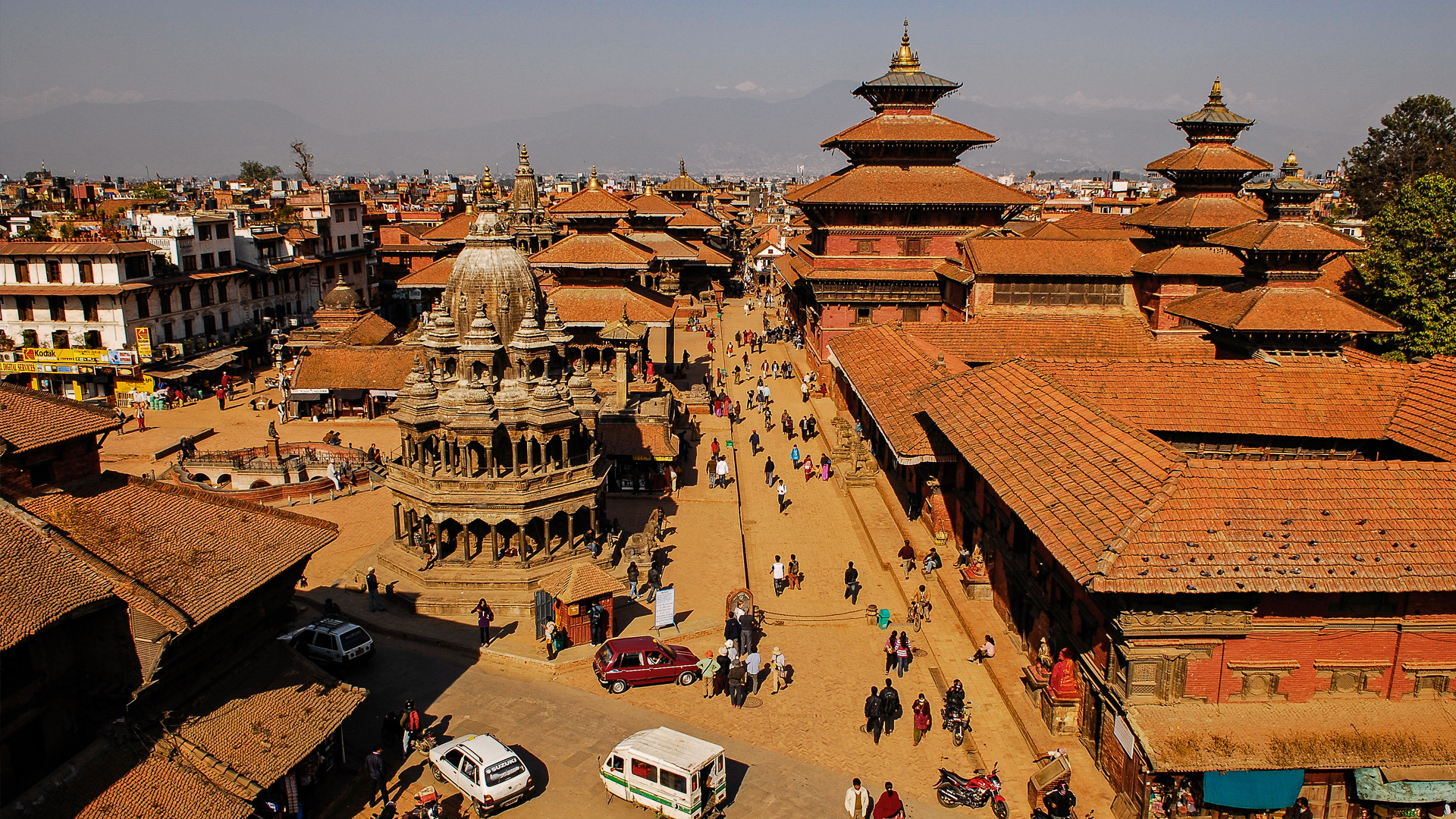
Things to Know:
- It is a UNESCO World Heritage Historical Site, with a dense amount of architectural wonders.
- The Krishna Mandir is the only place where a few on site monuments were fully and only built in stone.
- The square has temples for Bhimsen, Vishwanath, and Taleju as well.
- The Royal Palace was the royal seat of the Malla kings.
- The square is still actively used for social purposes, thus making it a living heritage.
3. Hiranya Varna Mahavihar (Golden Temple): Hidden Buddhist Gem
Hiranya Varna Mahavihar (The Golden Temple) is one of the most important Mahayana Buddhist monasteries in Nepal and nestled in the narrow and winding streets of Patan. Dating to the 12th century, the temple is shining and gilt on the outside, highly decorated with intricate wood and metal carvings and it has two lions (a resting lion and a standing lion because he wants to have one more chance to kill). The temple is an active sacred space for spirituality and pujas and rituals when it is open as a functioning monastery.
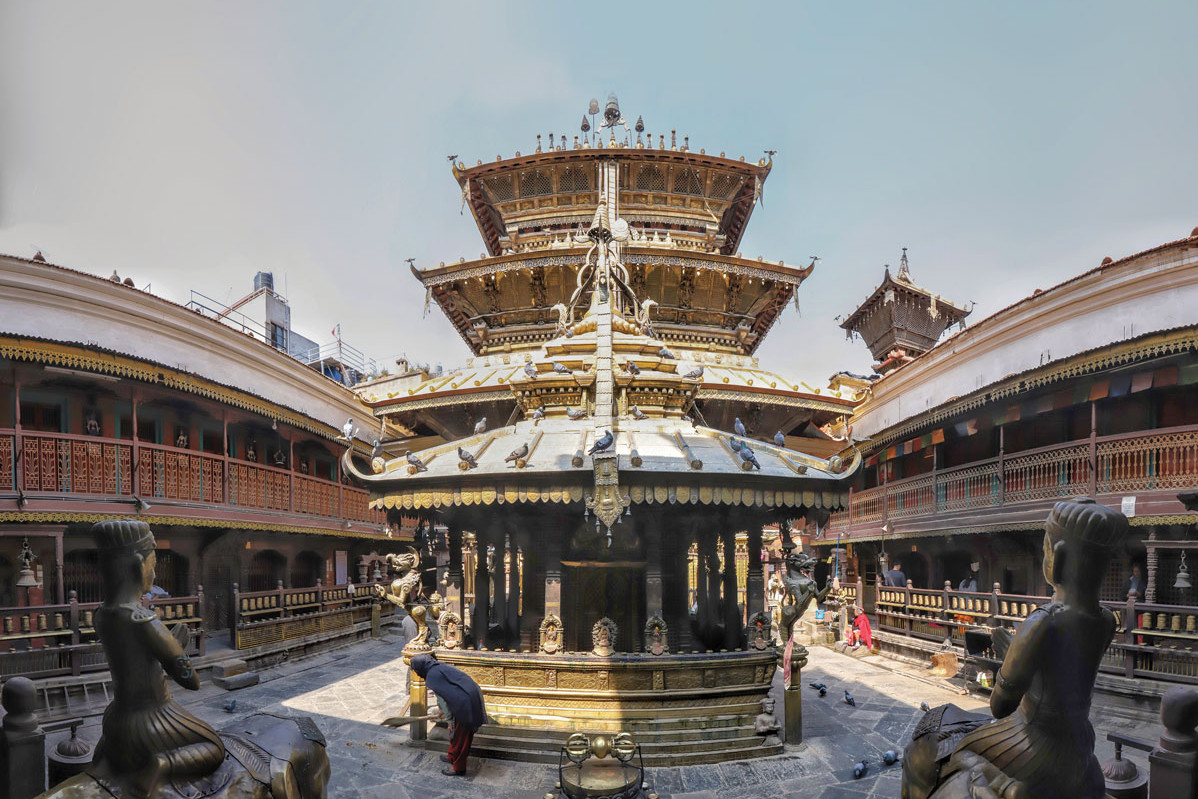
Rituals occur every morning performed by the young boys, Bapachas, who will go on to serve infrequently in the priestly vocation. All around heated butter lamps burn and flicker along the gilded walls and murmurings of prayers echo within the courtyard. The leadership of Hiranya Varna Mahavihar show the monastic life of that in Patan, forever courted but always upholding the unimaginable tradition of Tibetan Buddhism. The temple is almost a hidden refuge from the unknowing common; this furtiveness is only just a short distance away (5 minutes walking) from a bustling square in Patan.
Things to Know:
- Mahayana Buddhist monastery built in 12th century.
- Remarkable giltwork and gilded yard.
- Still functional and regularly performs prayers and rituals.
- Rituals performed by Bapacha boys, a distinctive practice.
- An oasis of calm and spirituality in the middle of the city.
4. Patan Museum: A Class of its Own in Newar Art
The Patan Museum is set in the former royal palace complex of Patan, and is an impressive entry point to exploring Nepal’s artistic and spiritual heritage. The Patan Museum houses finely curated collection of bronze icons, wood carvings and saced art pertaining to both the Hindu and Buddhist traditions. Established through the collaboration of Nepali and Austrian practitioners, the Patan Museum was magnificent restored and preserved to balance the architectural heritage of the site, whilst being an inspiring interactive learning opportunity.
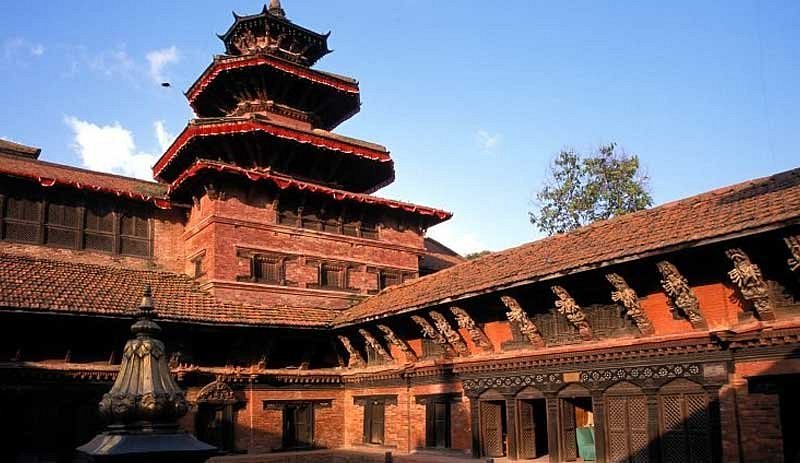
Unlike typical museums that showcase objects, this museum takes a thematic approach and provides an education to visitors regarding the meaning of the objects symbolized, the religious context, and the traditional techniques of the objects, particularly significance to Newar bronze casting. In addition to the exhibitions it offers a relaxing environment in its courtyard and rooftop café that will allow visitors to reflect and appreciate art and history around them.
Things to Know:
- Located in the Patan Royal Palace.
- Has one of the finest collections of Newar art in South Asia.
- Provides exposure to Hindu and Buddhist iconography.
- Provides an exposition of traditional, lost-wax bronze casting techniques.
- Has a restful courtyard and café for its visitors.
5. Community Courtyards: Patan’s Hidden Treasures
The most delightful aspect of Patan are its bahals—traditional community courtyard spaces that capture the spiritual and community life of Patan’s neighborhoods. Bahals can contain small stupas (mound-like structure containing Buddhist relics), prayer halls and/or often a public water source (hiti). Rather than being remnants of architecture, the bahals are vibrant social spaces where people come in daily, prayer in the morning, who could meet and socialize as a community, and remember the dead.
Some examples of excellent intact bahals are Nag Bahal, Kwa Bahal and Sundhara; to find and witness a courtyard like these that spatially communicate how urbanism made possible a way of being that nurtured community, spirituality, and social life is a rare find. bahals like these demonstrate the Newar way of being communal, where architecture included the social, and spiritual life without impediment. Furthermore, in these bahals we can see, although admittedly slower, a livelier, visceral urban life still pulsing.
Things to Know:
- Bahals are traditional courtyards that focus on Newar community civic life.
- A long Bahal often has a stupa, water spout, and prayer space.
- Nag Bahal and Kwa Bahal are in excellent condition and are used for communal activities.
- Bahals can be functional spaces for communal rituals, play, and socializing.
- Demonstrate the ways in which Patan is unique in the combination of architecture with community-life.
6. Artisan workshops and modern art spaces
Patan remains the artistic core of Nepal, where traditional craft methods permeate the thrumming, artisan workshops located in packed backstreets. Metalworkers fashion elaborate deities out of liquid metals using the lost-wax process, woodworkers create elaborate doorways, while thangka painters create divine details. In Patan, many families have retained these techniques through the generations, encompassing the artisanal spirit of Nepal and maintaining the artistic traditions based either knowledge or devotion.
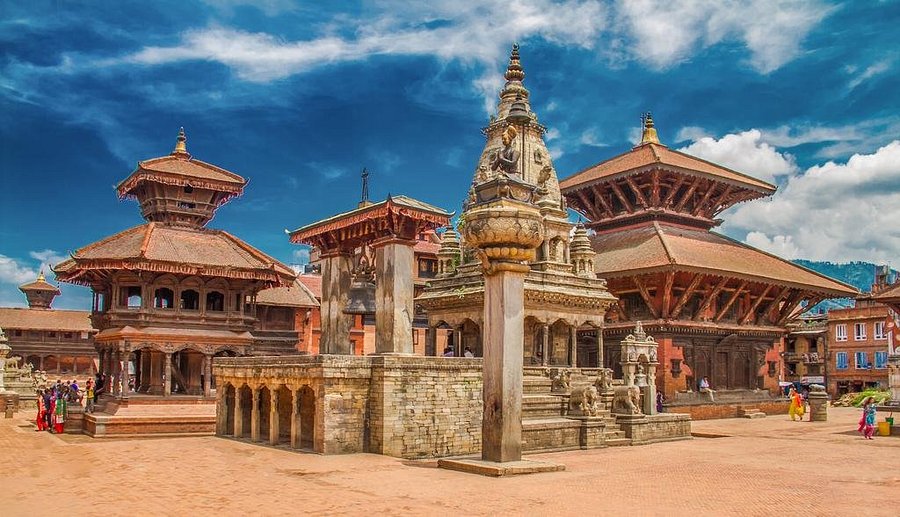
Patan also welcomes newness, with galleries such as Yala Mandala, Mcube, and Sattya providing a way for contemporary artists engaged with issues today in methods from the past. Through exhibitions, artist residencies, and studios these galleries provide dynamic spaces where history drives newness. In Patan tradition and creative expression do not compete, they speak to one another and grow. Patan provides expansive possibilities.
Things to Know:
- Patan is the craft capital of Nepal with master craftspeople.
- Premium quality metalwork, wood carving and thangka paintings.
- Lost-wax casting of statues is local specialty.
- Modern gallery spaces, to showcase new work such as Yala Mandala and Mcube.
- Patan is a mash-up of centuries old mastery of craft and contemporary.
Part II: Bhaktapur – A Medieval Marvel Frozen in Time
1. The Spirit of Bhaktapur
Bhaktapur, Khwopa in the Newar language, is often called Nepal’s “cultural jewel.” Only 13 kilometers away from Kathmandu, Bhaktapur is timeless and unspoiled by the frenetic natural and unnatural chaos of other urban centers. Once the capital of the Kathmandu Valley, Bhaktapur is still regal, with beautiful streets full of heritage and sacredness, and the inhabitate are traditional people. the city has the same brick houses, courtyards, and narrow alleyways, but lost in the centuries of the past History in the Making and both craftsmanship.
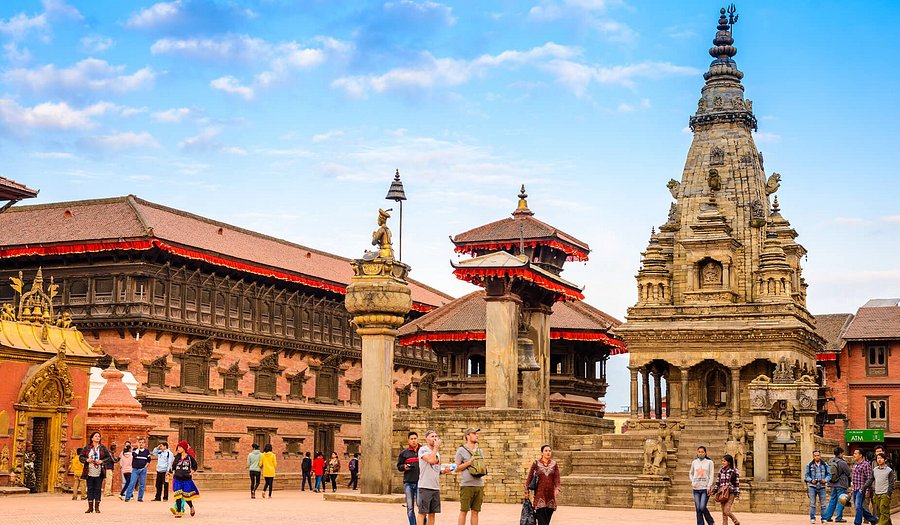
There is no other place in the valley like Bhaktapur that still move in time with the cadence of medieval days. Festivals, music, and arts joint the daily lives of the inhabitants as a part of their lives; not a display of ceremony. The city is one giant museum where the movements are literally at the pace of a glacier by the centuries of ritual tied to the sacred past, that are still in practice. In the courtyards grains are being dry by farmers, in the village square pottery is being form by artisans, and on the sun-dry stairs of temples old men are discussing the events of their day. While you do not physically witnesses the experience of Bhaktapur from what you see, you do experience Bhaktapur.
Things to Know:
- Bhaktapur is the most intact medieval city in the valley
- Used to be the capital of the whole Kathmandu Valley.
- Is Khwopa in the native Newar language.
- Is part of everyday life with architecture, rituals and traditions.
- It is like walking into a live history museum.
2. Bhaktapur Durbar Square: The Artistic Hub of the City.
In the heart of the city is Bhaktapur Durbar Square, a UNESCO World Heritage site, and the spiritual and political heart of the previous kingdom. The 55-Window Palace is the focal point of the square, lasting woodcarving that can only be matched with the artisanship used by Newar artisans. Next to the palace is the Vatsala Temple, made of Stone is for Vatsala Devi followed by a statue of King Bhupatindra Malla showing a gesture of Devotion.

Unlike the Durbar Squares at Patan and Kathmandu, which are confined public areas, the Bhaktapur Durbar Square is a relatively bigger and more open public space. However, this is not a point of history, which you are likely to visit once, in a time before. Bhaktapur Durbar Square works as a public square through which people pass, leave offerings, clean the temple plinths, and perform cultural rituals. The sacred and civic are intimately linked within the square, and it still remains the best place in Nepal to experience both.
Things to Know:
- Home of the 55-Window Palace, the iconic symbol of craftsmanship in wood;
- Home of Vatsala Temple and statue of King Bhupatindra Malla;
- A UNESCO World Heritage site still used for living practices;
- Bigger and more open than the other two squares in the valley;
- Varied public festivals or cultural rituals still taking place throughout the year.
3. Nyatapola Temple: Towering Over the Valley
Nyatapola Temple dominates Taumadhi Square and is the tallest pagoda type temple in Nepal at five stories high. Built in 1702 by King Bhupatindra Malla, there is both structural genius and one can see power at two levels, the architectural and spiritual levels. The temple has survived several significant earthquakes, possibly in part, because of the broader base and tiered design, further engineered to resist earthquake impacts.
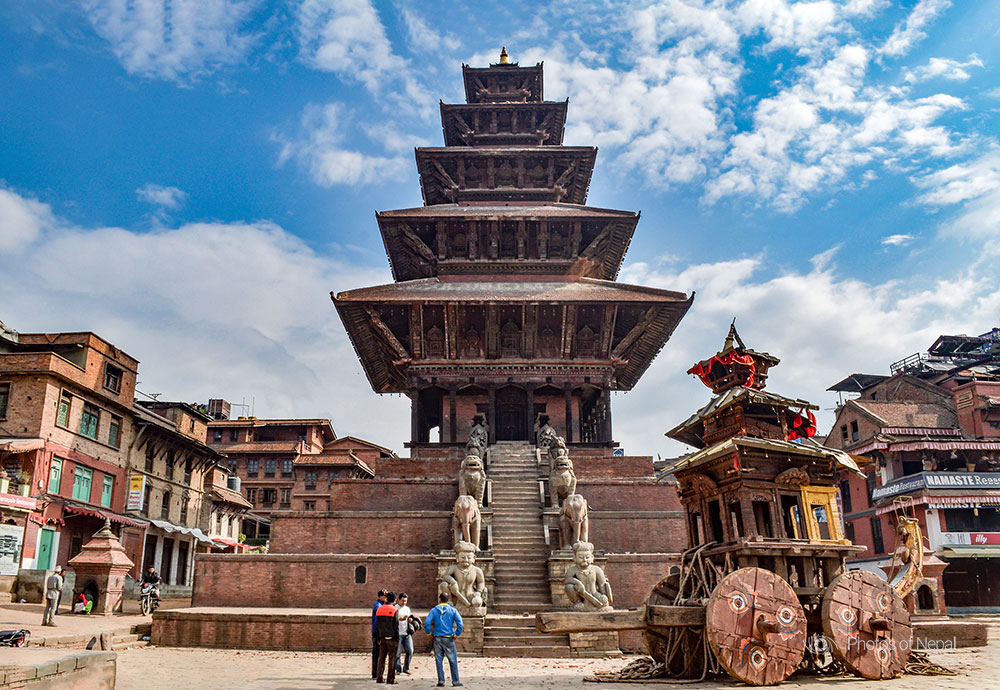
The stairway to the temple has groups of mythological figures representing double the strength of the previous figure way leads to the kalasa above the sanctum of Siddhi Lakshmi, a Tantric deity. Each level tells the story of two groups of figures; while the temple’s highest level represents an ascent in spiritual strength. The temple is simultaneously a physical journey upward as well as a metaphysically journey onward.
Things to Know:
- You will witness the tallest pagoda temple in Nepal, built in 1702.
- The temple is dedicated to the potent Tantric goddess Siddhi Lakshmi.
- The shape of the temple is designed to endure massive earthquakes.
- The temple is protect by symbolic stone guardians on either side of the stairs.
- Every level is a higher level of spiritual power.
Dattatreya Square and the Peacock Window
Dattatreya Square is at the far eastern end of Bhaktapur. It takes it’s name from the Dattatreya Temple, which was also thought to be built from one tree. This square feels more like a residential area (and artisan) and is much quieter than the central square but again just as stunning, and with the same amount of spirituality and craftsmanship at every turn. The Dattatreya Temple is in the middle of the square with its odd three headed deity which is a combination of Brahma, Vishnu, and Shiva.
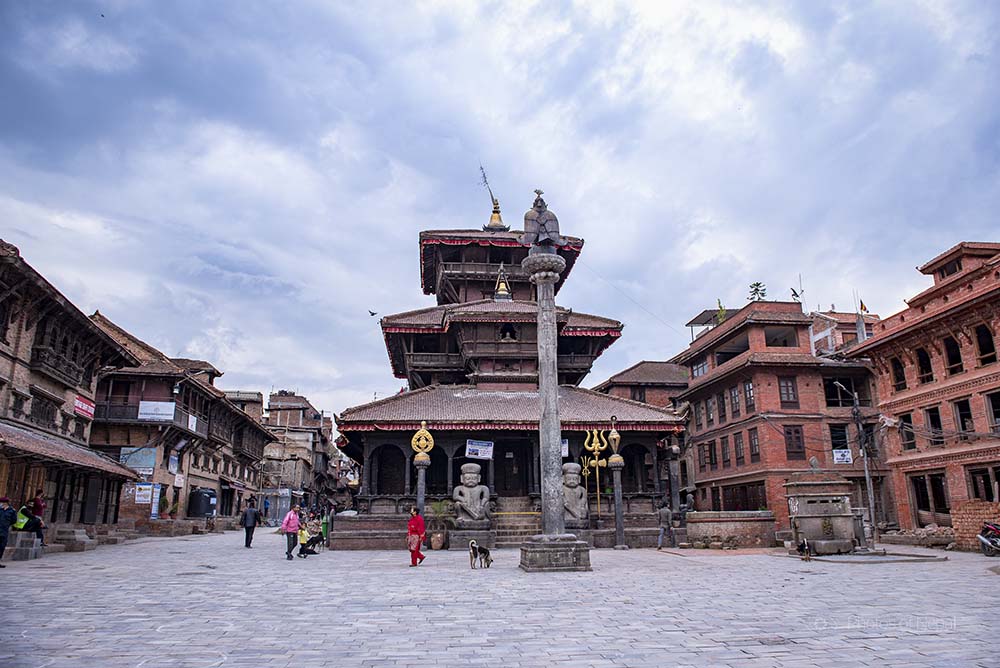
Art enthusiasts flock to this square to see the Peacock Window – referred to as the “Mona Lisa of Nepalese woodcarving”. This square also contains two fantastic museums; the Woodcarving Museum and the Brass & Bronze Museum. Both museums are located in a traditional building that reflects and help preserve Bhaktapur’s artisan structures.
Things to Know:
- Dattatreya Temple is said to be carved from one tree.
- The Peacock Window contains exquisite woodcarving.
- A beautiful synthesis of spirituality and tradition.
- Is the home to the Woodcarving and Brass & Bronze museums.
- A quieter square, more intimate and rich in history and artistry.
5. Pottery Square: The Rhythm of Clay
Often referred to as Talako Tole, Pottery Square is one of the most enlivened enclaves in Bhaktapur where you will find this community shaping pots as part of daily life. Craftsmen will sit lateral at a wheel, giving clay a squeezing motion, continuously removing the clay from the wheel until they have shaped a bowl, piggy bank, water jar, or traditional lamp. After the potters have shaped all of their pieces, they will place them in rows on the ground to let the sun dry them as they prepare to home-fire the pieces in traditional kilns.
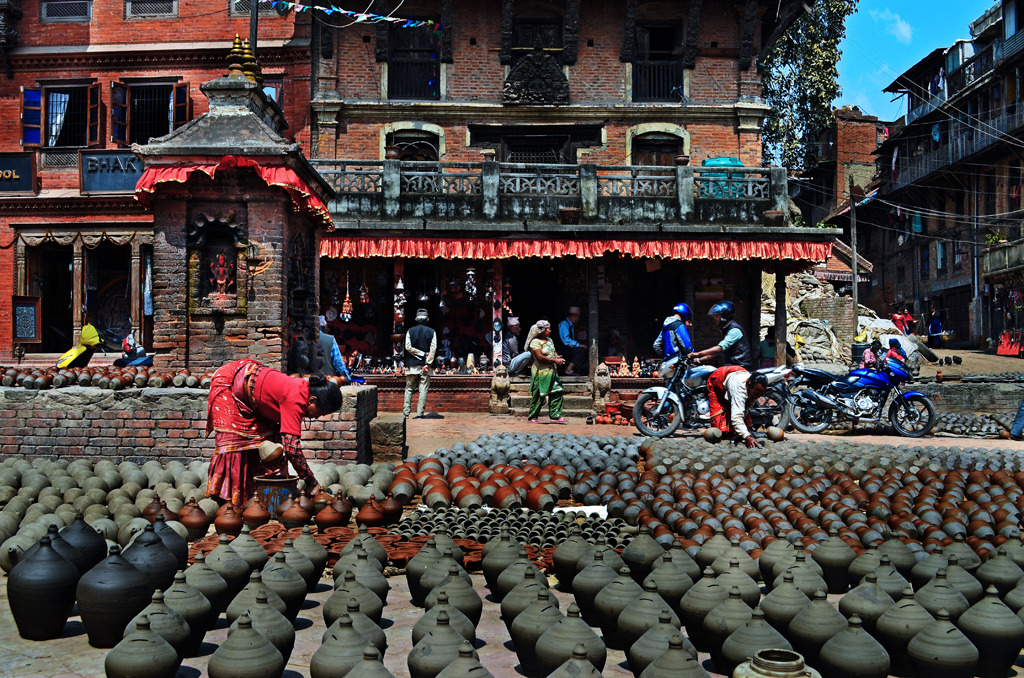
The pottery makers have demonstrated an unbreakable line of practice and the act of watching, their motions and the clay and wheel, the smell of earth, and the quiet contemplation, gives viewers a tangible and immersive experience. In Bhaktapur pottery is more than craft, it is the pride of ancestral wisdom and collective local identity.
Things to Know:
- Pottery Square is the world’s only place for traditional clay works.
- Artisans shape and sun dry their pots with no walls during the whole process.
- Firing still happens in traditional kiln.
- Generational learning secures its future.
- It provides the tourists chance to try pottery, creating engagement.
6. Bhaktapur’s Food Culture: Juju Dhau and more.
As there was the history and craft of Bhaktapur to the stomach, there were not insignificant moments of gluttony, particularly for the taste buds. The traditional delicacy of Bhaktapur is Juju Dhau, which translates to “King Curd”. Juju Dhau is a rich sweet yogurt made with buffalo milk and is housed in small clay pots. Juju Dhau has a creamy texture that holds its shape and is typically consume during festivals and rituals or simply indulge for the joy of eating on a hot day.
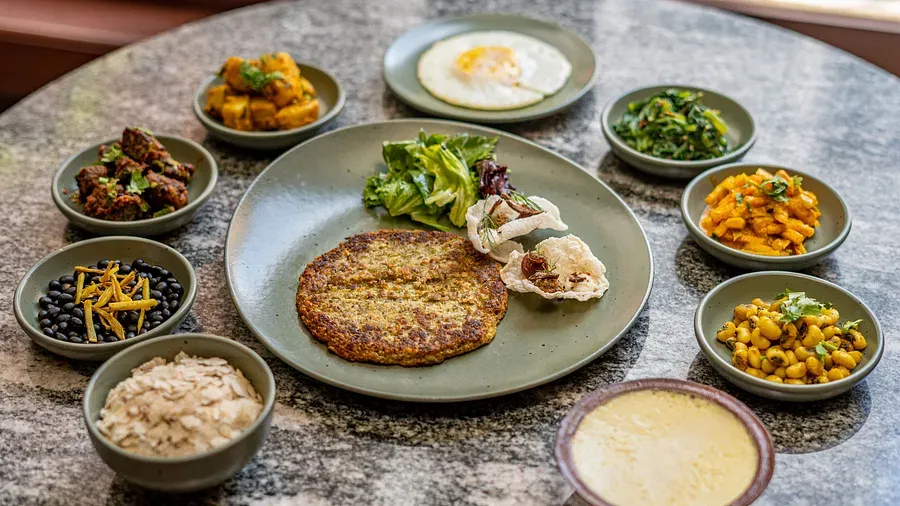
Food is also deeply influence by custom in Bhaktapur and food is strongly tie to their heritage. Juju Dhau, the “king of curd,” richness of cream, is only available in Bhaktapur. Chatamari is a rice flour pancake, normally eggs or minced meat, commonly referenced as “Newari pizza”. Bara is fry lentil patties that may be eat plain or fortifie with meat. Samay Baji is a ceremonial dish, served only at festivals, served in a round platter. It consists of beaten rice, boiled egg, fried meat, black soybeans, and ginger; a complete meal in balance of all textures and flavours; with the historical meal at its core. In this sense food is not just food, but heritage served to you on a plate.
Things to Know:
- Juju Dhau; the “king of curd,” cream-rich, comes from Bhaktapur
- Newari traditional dishes include Chatamari & Bara
- Samay Baji is a ceremonial food that is symbolic of festivals being ceremonial, Samay Baji is sympathetic of historical dinner— ceremonial meal
- Food and culture is important what signifies identity of Bhaktapur.
Shared Legacy: Patan and Bhaktapur as Twin Pillars of Culture
Although Patan and Bhaktapur became two distinct Malla states, their cultural roots are still very much within a Newar context. The Newars, Kathmandu Valley’s original inhabitants, indelibly stamped both patan and Bhaktapur with a Newar culture that permeates all aspects of life, including language (Nepal Bhasa), festivals, rituals, arts, architecture, etc. The walking experience of any pavement (which is brick) in either city has a commonality of Newar environment, whether in sculpture or architecture, such as elaborately carved woodwork, tiered temples, vivid courtyards, and hybrid architectural forms that blend function and form and create historical identity. The Indra Jatra, Machhindranath Jatra, and Bisket Jatra are festivals that are not simply social fodder, but they contain resonant meanings of our collective memories of ancestral survival, identity, and spirituality; while full of masked dances, chariot processions, sacred rituals, etc., these festivals are temporal and spatial bridges between cities and generations.
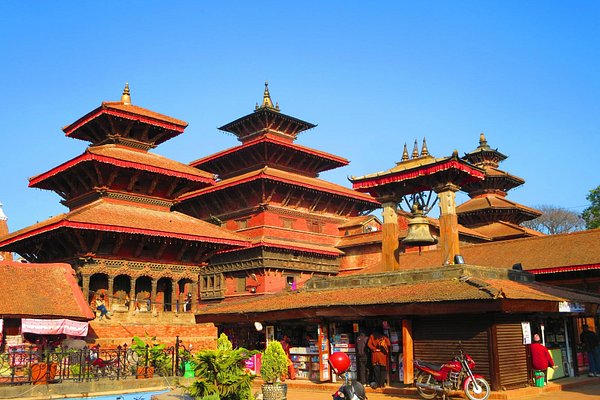
In addition to cultural festivities, Patan and Bhaktapur are the epitome of Hindu-Buddhist syncretism’ an enduring feature of Nepal’s religious landscape. In both instances you can find a Mahayana Buddhist monastery next to a Hindu temple for Shiva or Vishnu. Rituals are interchangeable and places are interchangeable; Buddhist’s worship in Hindu temples and the reverse is true as well, and this is the rule, not the exception. This is not just an intercultural space; it is an intercultural celebration as portray by Patan and Bhaktapur together as twin guardians of a world view where own faith is not demarcate from another, reinforcing the idea of spiritual tolerance that transcends institutional religion. Together Patan and Bhaktapur are protectors of a rich legacy and model of practice of ‘on faith’ that permeates Nepal’s ability to appreciate diversity while maintaining a sense of community.
Things to Know:
- Both cities are on a primordial Newar foundation and civilization.
- Both cities would share the same language, rituals, art, and architectural experiences.
- Major festivals as part the Newar socio-cultural festival calendar such as Indra Jatra, Machhindranath Jatra, and Bisket Jatra.
- Patan and Bhaktapur represent Hindu-Buddhist syncretism.
- Their cultural and religious harmony are the definers of the Kathmandu Valley.
How to Get There
Patan is easily and quickly available to get to from Kathmandu. The taxi drive will take about 20 to 30 minutes depending on traffic, so it’s a great place to go after the morning, or make a half-day trip, or even a full day. You can take a taxi, go with a ride-share service, or take any of the local buses from parking areas like Ratna Park or Lagankhel. Once you arrive in Patan, particularly near Durbar Square, you can walk to about 95% of the places you will want to visit and none of them are far enough to need additional transportation.
Bhaktapur is really not that much further from Kathmandu; it just takes a bit longer to get to Bhaktapur. A taxi driver should take between 45 and 60 minutes, as it takes a taxi ride out of Kathmandu. Once you are outside of Kathmandu, if you take any of the local buses at Ratna Park or either Bagbazar or Gongabu Bus Park, you will be on your way. The view is beautiful that I’ll let you to see for yourself with the terraced hills, and small towns along the drive to the medieval gates of Bhaktapur.
Successful tours of Bhaktapur may take some time. Because Bhaktapur is more extensive than Patan, if you visit the popular tourist attractions (e.g., Durbar Square in Bhaktapur, Taumadhi Square, Pottery Square, etc.) all these attractions are still either walking distance away near the limited number of places you didn’t need a taxi or public bus to visit.
Entrance Fees
Each city has established entrance fees for foreign tourists. The fees are levied to help protect and preserve the management of their cultural heritage. The Patan Durbar Square entrance fee is NPR 1,000 and the Bhaktapur Durbar Square fee is somewhere between NPR 1,500 and NPR 1,800, depending on the entry point and fee generated from the pamphlet or brochure. Entrance fees are never insignificant, but for the amount and quality of the architecture and artifacts, the entrance fees are completely reasonable.
Some entrances have been arrange for multiple entry, or there is a time period of validity from date-stamped entry, so make sure to keep both in mind when purchasing your entrance ticket(s). Many foreign tourists build in several days’ worth of visits to either city, so if you are going to be in Patan or Bhaktapur more than once, hold on to your ticket and ask the staff at the entrance gate about re-entry. Students with a valid form of identification from their school may also be entitle to discounted rates at attractions.
Best Time to Visit
The ideal time to visit Patan and Bhaktapur is in the autumn (October to December) and in the spring (March-May). In the autumn, not only do you have the experience of blue skies and the weather is good, but the festivals of Dashain and Tihar are a time where there are lights and flowers and celebrations all over the cities. In the spring, the air is clean, the plants are flowering, and in Patan there is the wild festival of the chariot festival “Machhindranath Jatra” where there are streams of people following the chariot.
It is easy to escape the crowds, and take advantage of the best light for your photographs, by planning your visit in the early morning, or in the late afternoon. In your quiet space at that time of day, you can enter your inner peace and quiet and think quietly about what the local people are doing. Where were they, as they started their day or finished their day. And, just as the sun started to set you were about to walk into the setting light; and in those moments, you could paint your thoughts with whatever thoughts were on your mind, hopefully about the days beauty and
how the light rested on the bricks of the temples, the wood carvings, and the open space of the squares.
Local Etiquette
Most areas allow photography; ask permission however for close-up photos of locals, artisans, monks, or during rituals. Most people will gladly offer up their stories and crafts to willing participants once asked about their experience.
Hiring Guides
Hiring a guide can move your visit from one that is purely sightseeing, to one which is a cultural experience that is engaging & enriching when you visit Patan or Bhaktapur. Most local guides speak a range of languages, have a good understanding of history, mythology, and architectural history that will help enrich your visit, and often they can explain their understandings of hidden symbolism that relates to certain statues, carvings, and the layout of the temples. It is also likely that they are aware of less-frequented courtyard’s and are familiar with some lesser-known legends and secret alleys that tourists miss.
A printed brochure or audio guide may do the trick when you want a brief glimpse of history; however, a human storyteller who walks you through the history and heritage of these ancient centres can bring stories to life. Guides obviously enhance the experience & richness of your visit; and they help to support the local economy.
Conclusion: Walking Through Legacy
Patan and Bhaktapur are not relics of the past, they are currently live and vibrant cities, and history must be alive in order to be remembered. They have endured tremors, modernization, and economics, so the tradition that serves as a strong root of their culture is inescapable.
While many in the modern world are emphasizing speed and doing things using technology, Patan and Bhaktapur allow us to slow down, look, and connect. Walking through Patan and Bhaktapur, is not visual sightseeing it is an artistic and spiritual exploration. You don’t just leave with a fingerprints of memory, you leave with an awareness of a way to be, thoughtfully in harmony with beauty, tradition, and faith.
